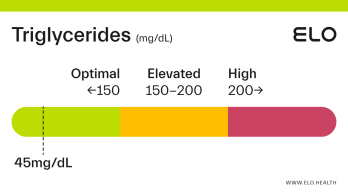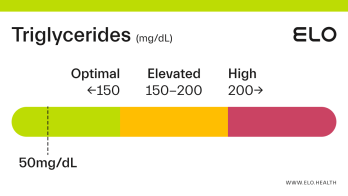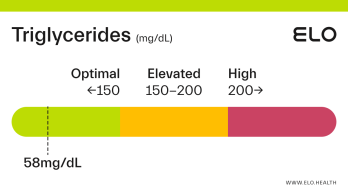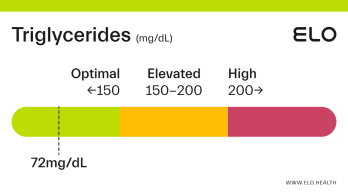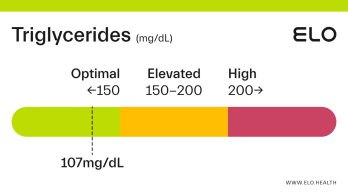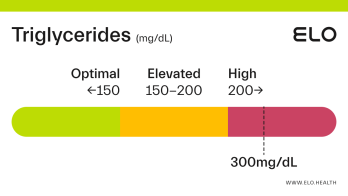Triglycerides: 84 mg/dL

What does a triglyceride test result of 84 mean?
A triglyceride level of 84 mg/dL is considered optimal. Having a healthy triglyceride level is associated with better heart health and a lower risk of heart disease.
Factors that impact triglyceride test results
Various factors play a role in triglyceride levels including your diet, weight, physical activity level, smoking, and alcohol consumption. Some medications and diseases can also impact triglyceride levels.
Diet: Diets high in fat, added sugar, and refined carbohydrates can increase triglyceride levels.
Weight. Excess body fat, particularly around the abdomen, can also increase triglycerides.
Physical Activity. Being active can help lower triglyceride levels.
Medications: Some medications including corticosteroids, beta-blockers, thiazide diuretics, antivirals, and estrogen, can raise your triglyceride level.
Some medical conditions: Thyroid, liver, or kidney disease, as well as poorly controlled type 2 diabetes, can change triglyceride levels.
Smoking: Smoking is associated with raised triglycerides.
Excessive alcohol consumption: Heavy drinking can increase triglyceride levels.
How to maintain optimal triglyceride levels
Keeping triglycerides in the optimal range is good for your overall health and can help lower your risk of developing heart disease in the future.
Triglyceride levels can increase over time, particularly as cholesterol levels increase with age, so it’s best to put heart-healthy habits in place now. Here are some things you can do to help keep your levels in the healthy range:
Exercise for 30-60 minutes 5x/week.
Lose excess weight by reducing calories.
Limit refined carbohydrates and consume fewer than 25g/day of added sugars.
Choose healthy fats like those found in nuts, seeds, olives, olive oil, avocados, and salmon.
Avoid trans fats and limit saturated fat to <10% of total calories.
Quit smoking.
Limit alcohol to 1-2 drinks/day.
References
Cholesterol Levels: What You Need to Know. (n.d.). U.S. National Library of Medicine | NIH. Retrieved September 9, 2021, from
https://medlineplus.gov/cholesterollevelswhatyouneedtoknow.html
Triglycerides: Why do they matter? (2020, September 29). Mayo Clinic.
https://www.mayoclinic.org/diseases-conditions/high-blood-cholesterol/in-depth/triglycerides/art-20048186
High cholesterol. (n.d.). NHS Inform. Retrieved September 9, 2021, from
https://www.nhsinform.scot/illnesses-and-conditions/blood-and-lymph/high-cholesterol
Cholesterol: Types, Tests, Treatments, Prevention. (2020, July 31). Cleveland Clinic.
https://my.clevelandclinic.org/health/articles/11920-cholesterol-numbers-what-do-they-mean
Blood Cholesterol | NHLBI, NIH. (2021, January 4). National Institutes of Health.
https://www.nhlbi.nih.gov/health-topics/blood-cholesterol
LDL: The “Bad” Cholesterol. (n.d.). National Institutes of Health. Retrieved September 22, 2021, from
https://medlineplus.gov/ldlthebadcholesterol.html

